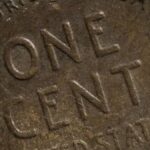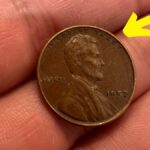The Lincoln Wheat Penny, a small yet iconic piece of American numismatic history, has captured the fascination of coin collectors and enthusiasts for decades. Recently, this humble coin has made headlines for its astonishing value of up to $50 million. But what makes this penny so special, and why is it still in circulation? Let’s delve into the history, rarity, and factors contributing to its immense worth.
History of the Lincoln Wheat Penny
The Lincoln Wheat Penny was first introduced in 1909 to commemorate the centennial of Abraham Lincoln’s birth. Designed by Victor David Brenner, this coin marked a significant departure from earlier U.S. coinage by featuring a portrait of a real historical figure rather than allegorical representations of liberty. The reverse side of the coin displayed two wheat stalks, symbolizing prosperity and agricultural abundance, which earned it the nickname “Wheat Penny.”
This penny was minted from 1909 to 1958 before being replaced by the Lincoln Memorial reverse design. Despite its modest face value, certain editions and errors have elevated the Wheat Penny to legendary status among collectors.
Why Some Wheat Pennies Are So Valuable
Not all Lincoln Wheat Pennies are worth millions, but a select few command staggering prices due to their rarity, condition, and historical significance. Here are some key factors that influence their value:
1. Rarity and Mint Errors
Some Wheat Pennies are rare due to limited mintages or production errors. For example, the 1943 Bronze Wheat Penny is one of the most sought-after coins. During World War II, the U.S. Mint shifted to producing pennies from steel coated with zinc to conserve copper for the war effort. However, a small number of bronze planchets (blanks) were accidentally used, creating an extremely rare coin. Only about 20 of these are known to exist today.
2. Historical Context
Coins minted during significant historical periods or events often hold special value. The Lincoln Wheat Penny’s association with Abraham Lincoln and its role in the economic history of the early 20th century make it a meaningful artifact.
3. Condition and Grading
The condition of a coin, assessed by its grade, plays a critical role in determining its value. Coins graded as Mint State (MS) or Proof are worth significantly more than those with wear and tear. A 1943 Bronze Wheat Penny graded MS-63 sold for over $1 million in a past auction.
4. Unique Characteristics
Coins with unique features, such as double-die errors or repunched mint marks, are highly prized by collectors. These quirks make the coins stand out and often fetch premium prices.
The $50 Million Lincoln Wheat Penny
While most Wheat Pennies are valued between a few cents and a few thousand dollars, some examples have reached extraordinary valuations. The $50 million Lincoln Wheat Penny is believed to be a rare specimen with impeccable condition, historical importance, and possibly unique minting characteristics.
Experts speculate that this penny may be:
- A pristine 1943 Bronze Wheat Penny.
- A unique error coin from an earlier or later minting year.
- A specimen with unparalleled provenance or history.
Its astronomical value stems from a combination of rarity, collector demand, and the mystique surrounding its existence. However, details about the exact coin and its owner remain largely speculative, adding to its allure.
How to Identify Valuable Wheat Pennies
If you have a collection of Wheat Pennies or stumble upon one in your pocket change, here are some tips to identify its potential value:
1. Check the Date and Mint Mark
Dates and mint marks (e.g., “D” for Denver, “S” for San Francisco) are crucial. Rare dates like 1909-S VDB, 1914-D, and 1922 “No D” are highly sought after.
2. Look for Errors
Inspect the coin for minting errors such as double-die obverses, repunched mint marks, or off-center strikes. These anomalies can significantly increase the coin’s value.
3. Assess the Condition
Examine the coin’s condition under good lighting. Minimal wear, sharp details, and a shiny surface indicate higher value. Coins in Mint State or Proof condition are especially desirable.
4. Consult a Professional
If you suspect your Wheat Penny is valuable, consult a numismatic expert or have it graded by a reputable service like the Professional Coin Grading Service (PCGS) or Numismatic Guaranty Company (NGC).
The Lincoln Wheat Penny in Modern Circulation
Despite being discontinued in 1958, Lincoln Wheat Pennies still occasionally appear in circulation. This is primarily due to their vast production numbers—over 1.1 billion were minted in 1944 alone. While most of these coins hold only sentimental or nominal value, the thrill of discovering a rare gem keeps collectors and casual finders intrigued.
How to Preserve Your Wheat Pennies
To maintain the value of your Wheat Pennies, proper storage and handling are essential:
- Avoid Cleaning: Cleaning coins can reduce their value. Leave them in their natural state.
- Use Protective Holders: Store coins in acid-free holders or coin albums to prevent scratches and tarnish.
- Control the Environment: Keep coins in a cool, dry place to avoid corrosion.
- Handle with Care: Always handle coins by the edges to avoid smudges or damage.
The Appeal of the Lincoln Wheat Penny
The Lincoln Wheat Penny’s enduring appeal lies in its blend of historical significance, aesthetic design, and the possibility of uncovering a hidden treasure. For many collectors, the hunt for rare Wheat Pennies is a journey through American history and an opportunity to connect with the past.
Conclusion
The Lincoln Wheat Penny, with its humble beginnings as a one-cent coin, has become a symbol of numismatic intrigue and American heritage. Its rare variants, such as the 1943 Bronze Wheat Penny, have reached values that defy imagination, with one specimen reportedly worth $50 million. While the chances of finding such a coin are slim, the story of the Lincoln Wheat Penny continues to inspire collectors and history enthusiasts alike.
So, the next time you come across a Wheat Penny in your pocket change, take a closer look—you might just hold a piece of history worth more than its weight in gold.







